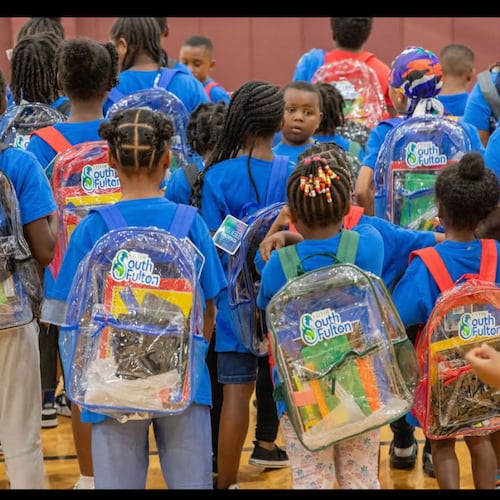Here is a list of some of Georgia’s gun-related incidents at schools and colleges.
Sept. 4, 2015: An 18-year-old student and a passerby were shot after a Grady-Carver high school football game.
Aug. 27, 2015: A 22-year-old student from metro Atlanta is shot to death in the student union of Savannah State University.
Oct. 3, 2014: A Fulton County high school student was fatally shot in a school parking lot after a football game.
Sept. 5, 2014: A Savannah State University student shot another student.
May 8, 2014: One person was shot in the parking deck of Georgia Gwinnett College.
May 5, 2014: A Paine College student was shot in the head after a drug deal gone bad, police said.
May 4, 2014: A Paine College student was injured by flying debris when someone fired into a dorm.
March 30, 2014: A shot was fired in university housing at Savannah State. No one was injured.
March 25, 2014: An argument between students led to shots fired in a Banneker High School parking lot in south Fulton County
Nov. 3, 2013: A Stephenson High School football player was shot during a fight with teenagers who were not students.
Sept. 21, 2013: A 20-year-old man was killed on the Savannah State University campus.
Aug. 20, 2013: A gunman fired shots at DeKalb County's Ronald E. McNair Discovery Learning Academy. No one was injured.
Feb. 27, 2013: A teenage girl accidentally shot herself in the thigh on the grounds of Grady High School in Atlanta
Feb. 1, 2013: A Clark Atlanta University student was charged with shooting a Morehouse College student after a fight. The victim's wounds were not life-threatening.
Jan. 31, 2013: A 14-year-old boy was shot in the neck at Price Middle School in Atlanta. He was treated and released. A 15-year-old boy was charged.
May 20, 1999: A 15-year-old student at Heritage High School in Rockdale County wounds six students with a .22-caliber rifle on the high school campus.
Middle school teacher Karen Bakshi watched intently as a police officer demonstrated ways to keep students safe if an armed gunman tried to invade a classroom.
Barricade the door with piles of desks and chairs to keep him out. Spray him in the face with a fire extinguisher to disorient him. Tackle him at the knees to throw him off balance.
“Can you imagine 10 years ago we would actually be learning this? You can’t even imagine it,” said Bakshi, a 27-year veteran teacher in Cobb County, during a recent training seminar given by Marietta police that showed educators how to protect students against an armed intruder.
“I want to be prepared in case this ever happens,” she added. “Hopefully you never have to use what you learn, but you need to know this because of the times we live in. It’s frightening, but it’s society.”
From more training for teachers to upping the number of police officers in schools to using increasingly advanced surveillance cameras and technology to keep out those intent on inflicting harm, Georgia's schools have beefed up security in the wake of the growing number of mass shootings on campuses and other public places.
The changes come at a time of growing anxiety among educators and students, who are being asked to go to greater lengths to protect themselves against shooters – fighting back against would-be attackers and buying security devices meant to keep gunmen out of classrooms.
With this increased focus on security, schools are struggling to find the right balance between protecting students but also creating a vibrant, welcoming place of learning, not a Fort Knox-like atmosphere.
For instance, when someone scrawled threats against students on a bathroom wall of Johns Creek High a year ago, it sparked an investigation and rumors of a looming attack. Many students chose not to come to school for several days.
“The following day, a Friday, I attended school, but around half of the students in my classes did not show,” wrote Andrew Liang, a student who described his experience for the Atlanta Journal-Constitution. “By the end of the day, close to two-thirds of my classmates were gone.”
Starting in the 2015 school year, school administrators locked the front doors during the day and told students not to open side doors. Students coming in late have to buzz into the front office.
“Our educational environment and comfort zones at school have definitely changed,” Liang wrote.
Ken Trump, President of National School Safety and Security Services, which consults for schools across the U.S., said safety has become much more part of the school mindset and culture.
“There are school leaders focused as strongly on safety as they are on academics,” he said.
In Fulton County, schools leaders are in the midst of an exhaustive survey to determine if educators are following safety plans to defend against a shooter. In Cobb and other counties, teachers are being directed to participate in seminars conducted by police, who share tips on what items teachers can use to protect themselves and what to do when law enforcement arrives.
In DeKalb County, where a gunman fired shots at Ronald E. McNair Discovery Learning Academy in 2013, though without any injuries or deaths, education leaders have hired close to 10 more school resource officers to patrol campuses. The shooter was talked out of harming anyone by Antoinette Tuff, the school bookkeeper.
Donald Smith, chief of police for DeKalb county schools, said that in addition to adding officers, the district increased collaboration with local police, who help advise and train educators.
“Now we’re in different times, we’re asking administrators and teachers and staff to do things they’ve never had to do before. Different times require different measures,” Smith said.
Gwinnett officials are installing in all elementary and middle schools a visitor management system (a buzzer/speaker system at the door). Also, an emergency notification system – which creates a direct link from each public school to the county’s 911 Center — has been installed in 65 schools and will eventually be in all of them, Gwinnett leaders say.
While the number of K-12 school shootings across the U.S. has remained steady in recent years, the overall number of mass shootings is on the rise, with close to 200 documented since 2000, according to law enforcement officials. Most happen in commercial places, followed by educational spaces.
There were 27 shooting incidents in K-12 schools between 2000-20013, according to FBI data, the latest available on the subject, and another 12 in colleges and universities. Among the most horrific school shootings was Sandy Hook Elementary School in Newtown, Conn., where a gunman killed 26 and wounded two at the school.
The number of gun-related student discipline incidents in metro Atlanta schools, which include the possession of firearms, is down slightly in Georgia, with 149 reported in 2012, and 128 in 2015, according to the Georgia Department of Education. While the chances of a shooter invading a school and doing harm remain rare, recent high-profile mass shootings in places such as Paris and San Bernardino, Calif., have educators on edge and focusing security efforts on that type threat, school security experts say.
“There is this increasing anxiety that’s out there,” said Ronald Stephens, executive director for the National School Safety Center. “Teachers do want to know what they can do rather than just standing there like a sitting duck and being shot.”
“For the most part, schools continue to be the safest place for children to be…much safer than at home or in their local community,” Stephens said. “Schools officials have done an incredible job making campuses safer. It’s about how do you strike a balance between making your school safe without turning it into an armed camp or a juvenile detention facility or like climate?”
Andy Cole, a 13-year educator, who teaches U.S. history at a Cobb County high school, has attended three active shooter training seminars. He said students are aware of the increased security and want to know more about how to prepare for such events. So far, he hasn’t seen the increased school security adversely effect learning.
“The better prepared I am, the more information I can have…it gives me a comfort level with it so I can discuss with my students,” Cole said. “It’s something the students are willing to discuss, and unfortunately it’s become part of our procedural discussions.”
“A lot of times when I talk to my students about this, there’s almost a sense of relief, that they take comfort in the fact that, ‘Hey somebody is thinking about me. Somebody is concerned about this.’ Having a plan in place is better than making it up as we go along.”
In the last 24 years, there have been close to 900 school-associated violent deaths in the U.S, according to the school safety center group. Homicide is the second-leading cause of death among youth aged 5-18, according to data from the CDC. But only between 1 to 2 percent of these deaths happen on school grounds or on the way to or from school.
Georgia law requires that every public school prepare a school safety plan to help curb violence in schools, to respond to such incidents, and to provide a safe learning environment. Some state legislators have also proposed arming teachers in the classroom, though that proposal has yet to win approval from lawmakers.
Safety plans vary by district and school and be inconsistently applied, however. For example, school staff don’t always follow all the required safety plan steps when it comes to letting visitors into schools.
It’s part of the reason why Fulton wants to survey its schools to make sure safety plan protocols are being practiced. School officials say that report is expected to be completed and presented to the school board in the coming weeks.
In addition, Fulton also plans to hold more training for educators in how to best prepare for an active shooter and other security concerns.
“You can never train enough to ensure the safety of our students,” said Patrick Burke, deputy superintendent of operations for Fulton schools. “The guidance around this has changed recently too. It used to be basically just shelter in place concept or hide. But the latest guidance you’ll see is called ‘Run Hide Fight’…. I think we can do a better job of training that.”
Some 800 Cobb County and other district educators, including Bakshi and Cole at the Marietta seminar earlier this month, were taught to "Avoid, Deny and Defend" — similar to "Run Hide Fight."
Police told the crowd that 20 of the 32 people killed during the 2007 Virginia Tech attack were shot lying in the fetal position and said the chances of survival are better if you fight back. They recommended: Move away from the source of the threat as quickly as possible, create barriers to prevent or slow down the threat and use any objects at your disposal as possible weapons, such as fire extinguishers, to fight off attackers.
“We just want to encourage them that if this situation happens, don’t just die. There is something you can do,” said Marietta police officer Brittany Wallace. “If there’s an active shooter, it doesn’t mean it’s all over.”
About the Author
Keep Reading
The Latest
Featured


